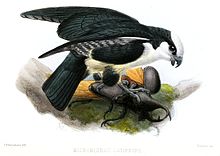White-fronted falconet
| White-fronted falconet | |
|---|---|

| |
| Scientific classification | |
| Domain: | Eukaryota |
| Kingdom: | Animalia |
| Phylum: | Chordata |
| Class: | Aves |
| Order: | Falconiformes |
| Family: | Falconidae |
| Genus: | Microhierax |
| Species: | M. latifrons
|
| Binomial name | |
| Microhierax latifrons Sharpe, 1879
| |

| |
The white-fronted falconet (Microhierax latifrons), also called the Bornean falconet,
The species inhabits open forests,
Taxonomy and systematics
The white-fronted falconet was first
The white-fronted falconet is one of five species in the falconet
Description

The white-fronted falconet is an extremely small shrike-like species of falcon, with a length of 14–17 cm (5.5–6.7 in), a mass of 35–65 g (1.2–2.3 oz), and a
The species may be confused with the black-thighed falconet, with which its range overlaps, but can be told apart from the latter and all other falconets by the colour of its forehead. The black-thighed falconet also has more intense reddish-brown on the belly and vent, along with white bars on the underside of the tail, which is pure black in the white-fronted falconet.[8][9]
The white-fronted falconet's vocalizations are not well-known, but are assumed to be similar to those of other falconets.[9] It makes a quavering kree-kree-kree.[3]
Distribution and habitat
The white-fronted falconet is
Behaviour and ecology
The white-fronted falconet is found alone or in groups of several individuals.[9] The generation length in the species is 3.2 years.[1]
The species mainly feeds on insects such as dragonflies, bees, and cicadas,[10] but has also been reported chasing birds. Hunting parties have been observed in November.[9] The species have been observed hunting from perches, making flights to catch flying insects and then eating the prey around two minutes after returning to the perch.[10] Other hunting behaviours are thought to be similar to those of other falconets, although there may be differences in the hunting techniques of the present species and the black-thighed falconet.[9]
The breeding season of the white-fronted falconet is thought to be either from March to June or from March to April,[8][9] although breeding has also been observed in November.[11] In Sabah, a male was seen feeding a fully-fledged chick in late July.[8] Nesting occurs in old barbet or woodpecker nest holes, with clutches comprising two eggs.[11] The incubation and fledging times are unknown.[9] Adult males have been observed preening each other, but it is not known if it breeds communally like the collared falconet.[8]
Status
The white-fronted falconet is classified as being
References
- ^ . Retrieved 14 February 2022.
- ^ a b "Appendices | CITES". cites.org. Retrieved 14 February 2022.
- ^ OCLC 944318084.
- ^ Sharpe, Rickard Bowdler (1879). "Contributions to the Ornithology of Borneo. Part IV. On the Birds of the Province of Lumbidan, North-western Borneo". Ibis. 4 (3). London: Academic Press: 237 – via Biodiversity Heritage Library.
- ISBN 978-1-4081-2501-4.
- ^ a b c Gill, Frank; Donsker, David; Rasmussen, Pamela (eds.). "Seriemas, falcons". IOC World Bird List. Retrieved 11 February 2022.
- PMID 15186800.
- ^ S2CID 241011146. Retrieved 13 February 2022.
- ^ OCLC 701718538.
- ^ a b c Irham, Mohammad; Meijaard, Erik; vas Balen, Bas (2012). "New information on the distribution of White-fronted Microhierax latifrons and Black-thighed Falconets M. fringillarius in Kalimantan, Indonesia". Forktail. 28: 162–163.
- ^ Ornis Mongolica. 1: 52–59.

